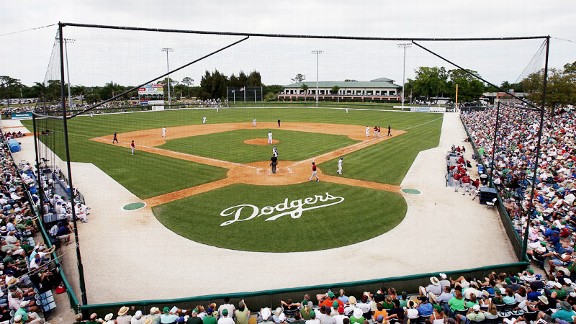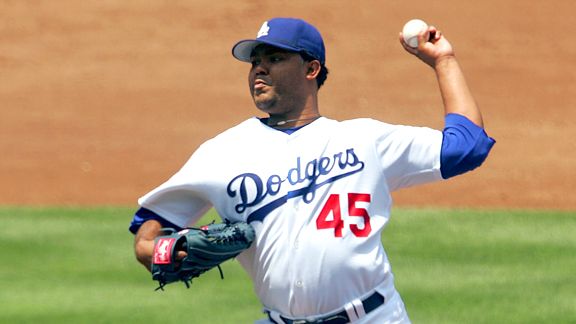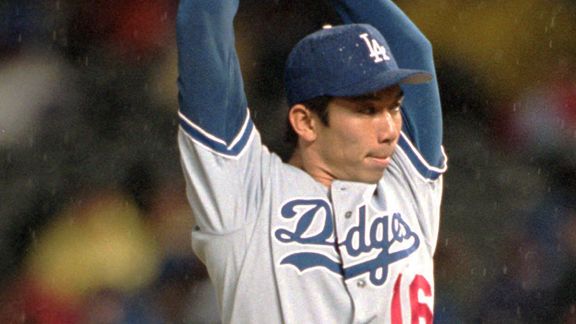A nice look back at Hideo Nomo’s career is provided by Jay Jaffe at SI.com, serving as a reminder of Nomo’s importance as a cross-continent pioneer.
Tag: Hideo Nomo (Page 2 of 2)
 Doug Benc/Getty ImagesA view from the final Dodger Spring Training game at Holman Stadium, March 17, 2008.
Doug Benc/Getty ImagesA view from the final Dodger Spring Training game at Holman Stadium, March 17, 2008.Former Dodger owners Peter O’Malley and sister Terry Seidler and former pitchers Chan Ho Park and Hideo Nomo have joined forces with Minor League Baseball to operate the old Dodgertown complex now known as the Vero Beach Sports Village.
O’Malley, a candidate to buy the Dodgers themselves from Frank McCourt, will be chairman and CEO of the new enterprise, and MiLB president Pat O’Conner will be president and COO, while Craig Callan will remain in control of operations of the facility, where he has worked for 33 years.
O’Conner said the goal of the group is to use the facility “for local, domestic and international sports programs” that will attract a variety of visitors.
“This combined effort of Minor League Baseball, the O’Malley and Seidler families and members of our extended baseball family will undoubtedly have a positive impact on Vero Beach Sports Village,” O’Conner said in a statement. “Peter O’Malley and his family have a long and storied history in Vero Beach and baseball in general, both domestically and internationally.
“Chan Ho Park and Hideo Nomo provide insight from a player’s perspective, as well as enormous credibility in Asia and the Pacific Rim.”
Nomo has been bringing Japanese youth players to the U.S. for the past couple of years for competition and cultural exchange.
“Being a part of the group that will operate a facility that provides youths with resources they can use both on and off the field is extremely rewarding,” Nomo said. “Those who come to the facility can improve not only as athletes through tournaments and training, but can also develop skills to help them mature into young men and women.”
Added Park: “I have many fond memories of Dodgertown from my nine seasons playing for the Dodgers. I love it there and look forward to seeing many teams and individuals enjoy all of the unique features of the complex and take full advantage of the amenities it has to offer, as I did when I trained and played there.”
For O’Malley, it’s a return to his roots — he was director of Dodgertown from 1962-65. Seidler worked there in the 1950s as the secretary for the Dodgertown Summer Camp for Boys.
“I embrace this wonderful opportunity to use this iconic facility that my family has cherished for decades to promote baseball,” O’Malley said in a statement. “Vero Beach Sports Village should always be an asset and a jewel to the citizens of Vero Beach and Indian River County, and I look forward to adding further luster to its rich history.
Though MiLB began operating the old Dodgertown facility in 2009 and events have continued to take place there, it has been in jeopardy ever since Dodger Spring Training left for Camelback Ranch in Arizona, with lots of speculation that it could eventually be sold off and converted for non-sports use.
“We know the Dodgers have a long-term spring training commitment with the community of Glendale, Arizona, and our endeavor in Vero Beach in no way impacts that relationship,” O’Malley said.
In other words, even if O’Malley ends up back with the Dodgers, don’t expect Spring Training to return to Vero Beach. Still, for fans of Dodgertown, this is welcome news.

Jeff Gross/Getty ImagesFor 4 1/2 seasons, the Dodgers never knew what they were going to get in Odalis Perez.
In the wake of the Jon Garland signing, Eric Stephen of True Blue L.A. looked at the most commonly used starting pitchers by the Dodgers since 2000, and in the process found that the Dodgers “have had five pitchers each start 30 games in a season just twice in their 127-year franchise history (1977 and 1993), and they have only had four pitchers start 30 games eight other times.”
Good stuff, but I was interested in something else, too. Given my surprise to find our starting rotation settled on paper before the end of November, I was curious how often in recent years the Dodgers had appeared to enter the season in better shape in their starting five than they’re in right now – and how they fared in those seasons.
Looking back at the 2000s (playoff teams in bold):
- 2010: Charlie Haeger won a beleaguered fifth starter competition. The current 2011 rotation, with Garland as the fifth starter behind Clayton Kershaw, Chad Billingsley, Hiroki Kuroda and Ted Lilly, looks better.
- 2009: Rookies Kershaw and James McDonald looked promising on paper, but most people would probably take the 2011 quintet, with Kershaw two years older.
- 2008: Brad Penny was coming off a 3.03 ERA in 2007, Chad Billingsley was rising and Derek Lowe in the final year of his contract, while Kuroda was untested in the U.S. and Kershaw hadn’t arrived. In fact, it was the rotating arms in the No. 5 spot (a shaky Esteban Loaiza, a green Hong-Chih Kuo) that helped hasten Kershaw’s debut. The Dodger rotation heading into 2008 was probably better than the 2011 group – until Friday.
- 2007: This was the year newcomers Jason Schmidt and Randy Wolf (the first time around) were supposed to anchor the Dodger staff, joining Lowe, Penny and Billingsley. This was an exciting group – until Schmidt and Wolf combined for 24 starts and a 5.05 ERA.
- 2006: Lowe, Penny … Odalis Perez (coming off a poor 2005) … Brett Tomko and Jae Seo. A little bit of wishful thinking, here.
- 2005: New free agent Lowe, Perez (coming off a strong 2004) and Jeff Weaver for the front three. The Dodgers knew they’d be dealing with filler at the No. 5 spot, and with Penny coming back late from his 2004 injury, they were duct-taping No. 4 as well, ultimately starting April with the likes of Elmer Dessens and Scott Erickson.
- 2004: The Dodgers’ first playoff trip of the century began with Hideo Nomo, Perez, Weaver and Kaz Ishii – not a bad front four if you thought the 25-year-old Perez would regain his 2002 form. The other three had ERAs below 4.00 the year before. The fifth starter left in TBD status until the job was seized by Jose Lima, who had a memorable year through and into the playoffs (after having thrown 503 2/3 innings with a 6.18 ERA since 2000), while Ishii ended up struggling and Nomo fell apart.
- 2003: Kevin Brown was coming off an injury-plagued 2002, but there was still hope for him (rightfully so) to lead a staff that also included a resurgent Nomo, Ishii and Perez (3.00 ERA in 2002). Darren Dreifort, attempting a comeback after going more than 20 months between games, got the first chance at the No. 5 start, but the Dodgers also had Andy Ashby (3.91 ERA in ’02) as a No. 6 starter. So there was depth, but also an understanding that the depth could be needed immediately.
- 2002: Lots of new blood to join Brown and Ashby: Nomo (returning as a free agent from Boston), Perez (acquired with Brian Jordan in January’s Gary Sheffield trade) and Ishii (signing his first U.S. contract on February 28) – not to mention Omar Daal, another returning former Dodger who came in an offseason trade from Philadelphia but began the year in the bullpen. By the time Spring Training started, the staff was deep – one of the reasons second-year manager Jim Tracy experimented with converting a guy who had made 24 starts in 2001 into a reliever: Eric Gagne.
- 2001: In his last year before becoming a free agent, Chan Ho Park was the Opening Day starter for the Dodgers, followed by Gagne, Dreifort, Ashby and – in place of Brown, who was limited by injuries – Luke Prokopec. Either Gagne or Prokopec were to be the No. 5 starters on paper, after making some waves in 2000. You might laugh now, but there was reason to think this could be a pretty decent starting rotation.
- 2000: You had Brown, Park and Dreifort, all coming off solid 2000 seasons. Then you had Carlos Perez, who had a 7.43 ERA in 1999. And rounding out the fivesome, you had the last gasp of Orel Hershiser, who had a 4.58 ERA with the Mets at age 40 the year before. It did not go well for this rotation.
In terms of Dodger starting rotations that had proven talent in all five slots since 2000, you’d have to look at 2007 and 2002 as the leading lights, with honorable mention to 2003. Neither of these teams, of course, reached the playoffs (though the ’02 team won 92 games), while the Dodgers’ past four playoff teams all had question marks in at least one spot in the starting rotation entering the season.
Giants at Phillies, 4:57 p.m.
* * *
Part 3 of Robert Whiting’s series on Hideo Nomo has been published in the Japan Times.

David Zalubowski/APWith raindrops falling, Hideo Nomo winds up to pitch to Rockies leadoff batter Eric Young on September 17, 1996, unaware that 27 outs later, he would have a Coors Field no-hitter. Nomo pitched from the stretch after the first inning to combat the wet mound.
Robert Whiting, author of You Gotta Have Wa, is writing a detailed four-part series for the Japan Times on the impact Hideo Nomo had on baseball on both sides of the Pacific. So far, part one and part two have been published, and they are very good reads.
Here’s a sample:
… The Prime Minister of Japan hailed him as a national treasure. It was a remarkable turnaround, given that only months earlier, Nomo had been criticized heavily for deserting his team and his country. Ironically, Nomo received far more attention as a major leaguer than he ever had playing for the lowly Pacific League’s Kintetsu Buffaloes, who toiled before sparse crowds and hardly ever appeared on nationwide television.
One could even credit Nomo for helping to repair U.S.-Japan relations, which had been in tatters because of trade disputes.
Not so long before Nomo had arrived in America, the relationship was at a 40-year low. The speaker of the Japanese parliament had labeled Americans “uneducated and illiterate,” while American congressmen had been railing at Japan over “unfair trade practices” and its fanatical corporate warriors.
A group of U.S. congressmen had even smashed a Japanese car to pieces on the Capitol lawn. But the love affair of MLB fans with Nomo helped to dissipate the acrimony between the two countries.
Nomo was on the cover of Sports Illustrated and Time Asia and the subject of more than one TV documentary.
The New York Times noted with approval a shift in the mood in Japan. “Nomo’s arrival in MLB,” wrote that prestigious newspaper, “signifies that the Japanese penchant for closed door exclusivity is receding.”
The Asahi Shimbun called Nomo’s success a “catharsis” for Japanese who were weary of the constant carping of the U.S. government over trade.
Nomo’s appearance in the 1995 All-Star Game in Arlington, Texas, was an historically significant moment, coming as it did almost exactly a half-century after the end of the Pacific War between Japan and the United States, and no one watching could escape its significance. A player from Japan had emerged to reignite the national pastime in a way that perhaps no native-born American could have, given the bitter emotions that remained over the strike.
He brought back all the feelings that baseball players used to inspire. He was modest, humble, shy, hardworking and a joy to watch on the field. That last sentence could have been used to describe a Christy Mathewson, Lou Gehrig or a Joe DiMaggio. It made Americans and Japanese stop and contemplate baseball’s role in cross-cultural relations. …
Of course, not all was sweetness and light. Occasionally, nationalism and even prejudice reared its ugly head. …
(Thanks to Brett Bull for the tip.)
* * *
Vin Scully Is My Homeboy passed along video of an old Hollywood Stars Night at Dodger Stadium from the 1960s, starting with a combo of Walter Alston and Phyllis Diller, followed by Milton Berle, Dean Martin, Mickey Rooney, Annette Funicello, Billy Barty and more. See if Nancy Sinatra’s boots are made for walking to first base …



